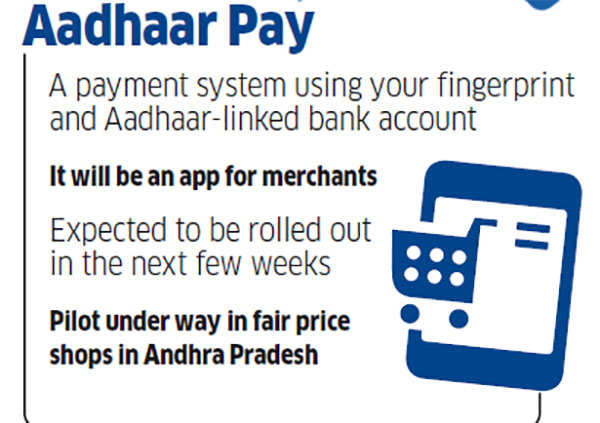The soon-to-be launched Aadhaar Pay will let you make purchases using your fingerprint
The article by Indulekha Aravind was published in the Economic Times on 15 January 2017. Sunil Abraham was consulted for this.
Ajay Bhushan Pandey, CEO of the Unique Identification Authority of India (UIDAI), says it will be rolling out Aadhaar-enabled payment system, or Aadhaar Pay, for merchants in the next few weeks. This will be an app for merchants that enables them to receive payments through biometric authentication of the customer, provided their bank accounts are linked to their Aadhaar number. "A pilot is under way in fair price shops in Andhra Pradesh where shopkeepers are accepting payments from PDS beneficiaries. The results are very encouraging," says Pandey.
The idea takes off from the existing Aadhaar-enabled payment system (AEPS) used by bank business correspondents (BCs) in rural areas to disburse and accept cash, using micro ATMs. "We are trying to tweak this so that a similar device can be used by a local merchant," says Pandey. Adoption will depend on two factors: merchants’ acceptance of it and whether they can use an app rather than a micro ATM. The biggest advantage through this method of payment, says Pandey, is that the customer will not need a credit or debit card, or even a smartphone.

The limits for transactions using AEPS, such as the number of daily transactions, will be left to the discretion of the banks. In the long term, the AEPS will be migrated to the BHIM (Bharat Interface for Money) platform but the rollout of Aadhaar Pay will happen before that. Post demonetisation, banking BC’s number of transactions using AEPS has leapt from 4-5 lakh to 14-15 lakh, says Pandey. According to Reserve Bank of India data on electronic payment systems, the total volume of such transactions jumped from 671 million in November 2016 to 957 million in December. USSD-based payments, which can be done using a basic feature phone, are among the biggest beneficiaries: the volume rose from just 7,000 in November to 1,02,000 in December, and value of transactions from over Rs 7,000 to over Rs 1 lakh. Prepaid payment instruments — mainly mobile wallets — rose from 59 million to 88 million in the same period (and value from Rs 1,300 crore to Rs 2,100 crore).
While Aadhaar Pay is likely to ride the demonetisation wave if it is launched soon, certain concerns remain, as the list is how secure such a payment system will be. The UIDAI CEO says it is a paramount concern for the organisation, too. "We are using the latest technology to ensure the information stays encrypted end to-end, so that information is not leaked or misused. In the months to come, we will strengthen the security."
Wary About Security
Sunil Abraham, executive director of the Centre for Internet and Society, a think tank that has been analysing the Aadhaar project for six years, outlines several reasons why Aadhaar-based biometrics is inappropriate for authentication in payments, unlike card-based payments that use cryptography.
"With biometrics, there is always an error ratio. It is imprecise matching, whereas with cryptography (smart cards), there is no false positive or negative. You either have the key (PIN) or you don’t. It is also very cheap to defeat biometric authentication — even an unlettered person can do it," says Abraham. It would be easy enough, he says, to replicate someone else’s fingerprint by pressing it against lukewarm wax and filling the mould with glue to get a dummy finger. In contrast, compromising a smart card requires more cost and effort, from tech-savviness to machines such as a skimmer that will read the card. "And once you are compromised,you are compromised forever. You can’t change it, like a debit card PIN."
Using Aadhaar for authentication had proved to be a failure during the exchange of currency notes following demonetisation, he adds, pointing to how the poor and the middle class stood in queues for money while stacks of new currency were recovered from the homes of businessmen and bureaucrats. "When you have bank officials who are corrupt, giving them your biometrics is giving them more ammunition for corruption." To catch the criminals, law enforcement agencies had to resort to CCTV footage,a relatively older technology, he says. Others point out that while it may be secure, certain factors stand in the way of making biometrics-based payment authentication a large-scale success. Amrish Rau, CEO of PayU India, a payment gateway provider, cites a list of reasons why it would inevitably take off but only in 5-10 years.
"For one, the technology is not yet good enough. There are also bandwidth and data constraints in sending biometric data," says Rau. Even in more mature markets, it has yet to find widespread acceptance, he says, pointing to the slow adoption of Apple Pay and Samsung Pay in the US. "It’s not the answer today.” This is in contrast to NITI Aayog CEO Amitabh Kant’s recent remarks that cards and PoS machines would become redundant by 2020 because Indians would be making payments using their thumb (biometrics). "... my view is that in the next two and a half years, India will make all its debit cards, credit cards, all ATM machines, all PoS machines totally irrelevant,” Kant had said at a Pravasi Bharatiya Divas session in Bengaluru.


